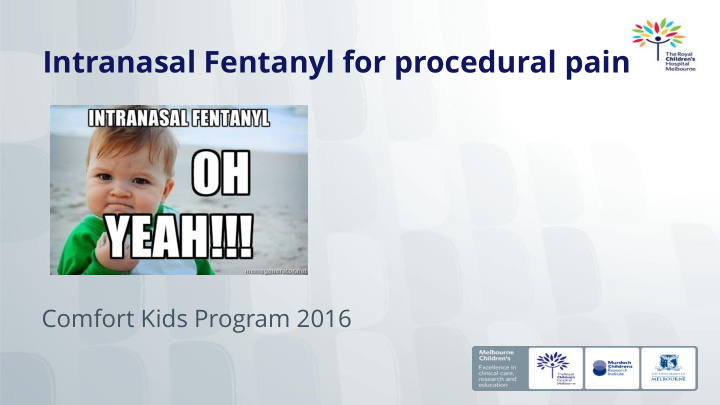



Intranasal Fentanyl for procedural pain Comfort Kids Program 2016
IN fentanyl • What • Why • How • Resources
What • Analgesic opioid • Rapid onset of effect 2-5 minutes • Duration of effect 30-60 minutes • If opioid or sedation agent administered within 2 hours, assess UMSS & undertake consultation
Why • Intranasal more effective than oral route • Enhanced absorption and avoidance of 1st pass effects • Theoretically direct nasal to CNS delivery allows lower dosing with less delivery to none targeted organs • Rapid onset • Titrated • Short acting
Indications • Age > 6 months (corrected age) • Minor painful procedures of short duration • Limited IV access • Potent & rapid onset of analgesia required • Single procedural analgesic agent • Adjunct to N20 (undertake risk assessment)
Indications • Paediatric minor painful injuries or procedures: • Orthopaedic trauma not requiring an IV (or prior to IV) • Pain control is needed but oral medication is too slow • Burn dressing changes • Re-packing wounds such as abscesses • IM shot for pain control (IN works as well or better with faster onset and no pain on delivery)
Contraindications • < 6months (corrected age) • UMSS ≥2 • Bilateral occluded nasal passage • Epistaxis
Dosing RCH CPG
IN Fentanyl order IP Procedural Sedation Order set Order set • IN Fentanyl Adjuncts • Topical LA’s ( Emla, AnGEL) • Sucrose Procedural Support • List of agents • EPT Referral • Links to PSWA Procedure & CPG’s Activates Nursing order • Sedation Narrator • Observations & Weight
IP Procedural Sedation order set Order Sets = Select from L panel Go to order sets = Select from R panel Search order sets = IP Procedural Sedation Favourites = R click to add Open Order sets = centre panel Select Medication & Sign
Documentation= Sedation Narrator Record of Sedation now SN EMR Checklists Locate in More – click to add to side bar - Open & Resize Accept Sedation Documentation Start Don’t file END until summary complete Start & End Bookend the Sedation Narrator
Sedation Narrator Views Event Log, Patient Summary and Orders Event Log = Checklists & Observations View Orders = IP Procedural Sedation Order Set Patient Summary = IP Summary
Sedation Narrator - Pre-Sedation Checklists appear in Left panel of SN as Active Alerts Mandatory to complete Pre-Sedation Checklist prior Show Row Info for PSWA Procedure tips for: Exclusion Criteria, Risk Assessment, Consultation Fasting, Staffing, Equipment, Consent & Preparation of Child
Sedation Narrator Intra-Sedation Checklists Intra-Sedation Checklist Time out/ Pt Identification & Continuous monitoring Observations/ UMSS captured in QuickBar & File Document if UMSS 2 – 5 minutely & use Notes to add N20 % / commentsTalking
Sedation Narrator - Intra-Sedation Document 5 minutely UMSS & Observations if UMSS > 1 Use Notes to make comments UMSS 2 N20 @ 60% weaned to 40% or Patient vomit FM02 Don’t forget to File your data Use Intra-Sedation Buttons for additional information - Right panel
Sedation Narrator Post-Sedation Checklists
Sedation Summary & Documentation END Procedural Sedation Summary – was this a Successful event or Not - AE’s Procedure attempts/ Sedation agent/ Analgesia ( includes LA) / Adjuncts (sucrose/ lip smacker) Non Pharmacological Procedural Support (EPT CF CKP & Coping strategy used) FILE End Bookend the event & SN complete
IP Summary -Sedation Timeline Go to IP Summary Left panel Sedation Timeline review previous Sedation events Add to IP Summary toolbar using Right top right
Administration Draw up appropriate dose for weight (CPG) • plus 0.1ml extra to the first dose (dead space) • Attach Mucosal Atomiser Device (MAD300) on to the end of the syringe • Sit the child at approximately 45 degrees or with head to one side • Directed MAD at 45 degrees to spray the turbinates • Do not direct MAD horizontally along the nasal floor • Avoid dose running into pharynx & swallowed (reduce bioavailability & • efficacy) Insert the device loosely into the nostril • Press the plunger quickly • Doses are to be divided between nostrils (1/3 to ½ ml per nostril is ideal) • If NGT. Can push up to 1 ml per nostril though some will run off ( titrate) • Do NOT draw up 0.1ml extra for second dose when re-using the delivery • device (MAD)
Administration
Mucosal Administration Device
A&P of the nose • Nasal mucosal surface area (150-180cm 2 ) • High blood flow • pH 5.5-6.5 maintains glycoproteins to which drugs attach • Nasal drug absorption depends on • Direct connection to CNS via the olfactory route
IN fentanyl – child
Adverse Effects • Respiratory depression • Hypotension • Nausea and vomiting- increase risk of vomiting when combined with N20 • Chest wall rigidity ( only reported with large IV doses) • Pruritus
Monitoring & Reversal • HR, RR, SpO2, UMMS monitored continuously • Naloxone bolus 0.1mg/kg IM or IV, maximum 2mg • Naloxone is effective, intranasal if you need a reversal agent • Remember extra volume into the syringe to account for the dead space that will remain. • Don’t use same MAD due "dead space“
Considerations • NGT • Bleeding • Opioid effect IN fentanyl • Patient require additional analgesia, consider timing the procedure with the patient’s baseline analgesia • N20
IN fentanyl N20 • The maximum percentage of N20 which can be delivered is 70%, with a minimum O2 30% • Additional opioid or sedation agents may have synergistic effect producing excess sedation • Assess before commencing N20 • If UMSS ≤ 1 N20 must be titrated to maintain UMSS ≤ 2 • If UMSS is ≥ 2 do not administer N20 seek consultation
Recap • Assessment • UMSS • Sedation narrator • Procedure • Pain • Dual agents • Consultation • Dosing • CPG / Procedure • Technique
RCH R&R • Procedural Sedation- ward & ambulatory areas - at RCH • Intranasal Fentanyl CPG • Intranasal Midazolam fact sheet • Prommer, , 2011 • Buck, 2013
Recommend
More recommend